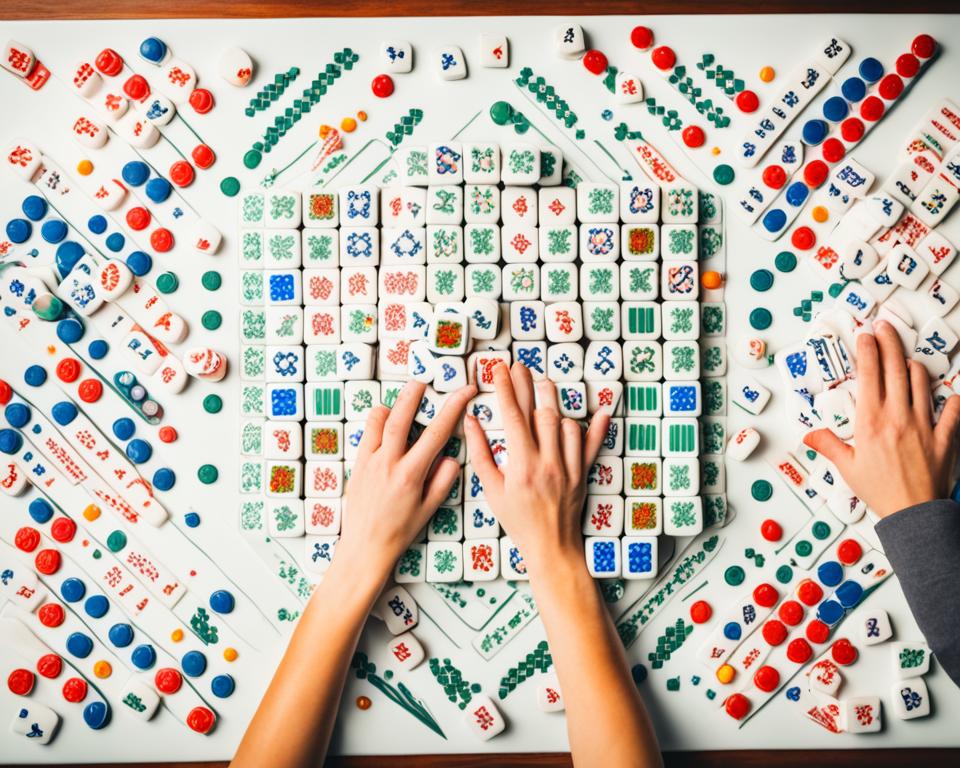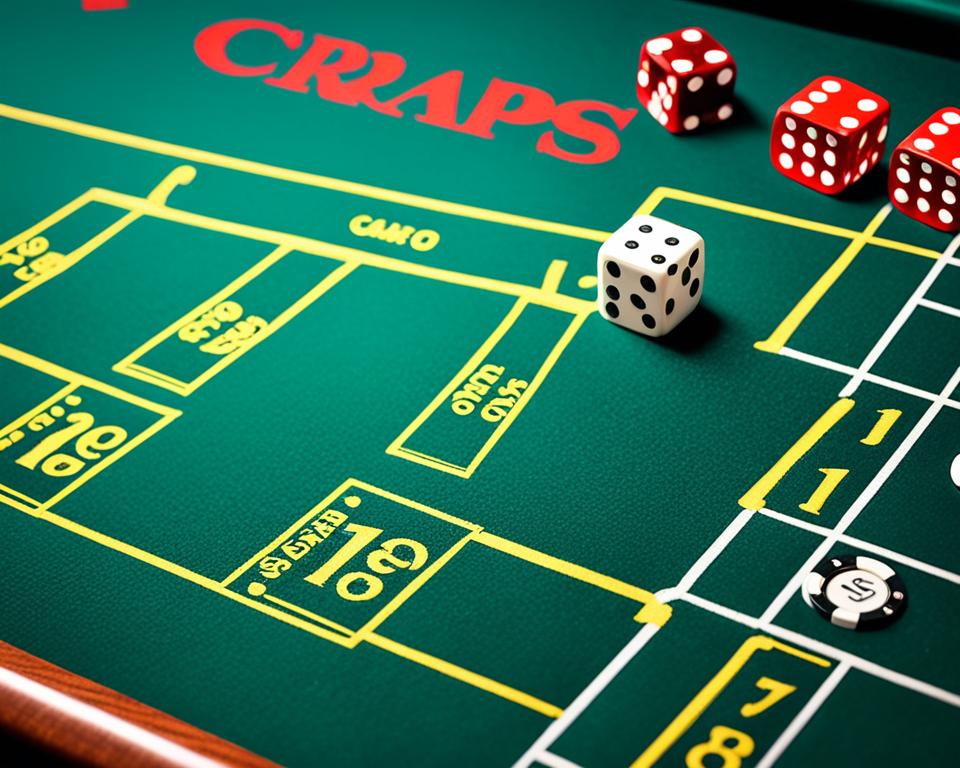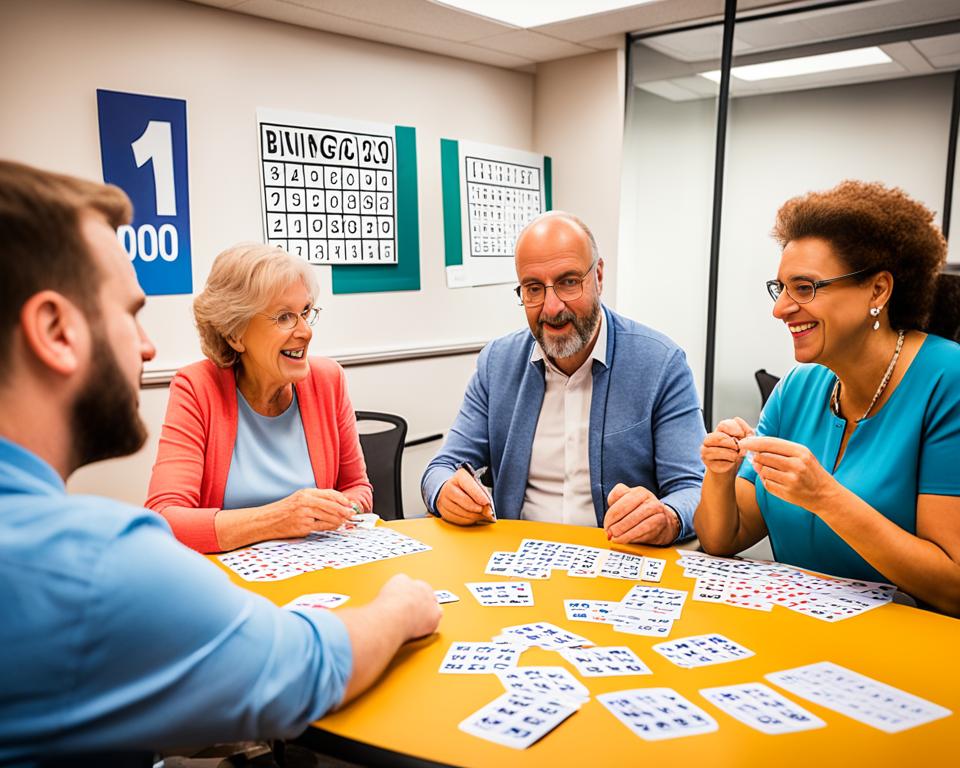Mahjong, a captivating game of strategy and chance, has captured the hearts of players worldwide. If you’re new to Mahjong and eager to dive into this exciting world, this article is for you. We’ll guide you through the easy Mahjong rules for starters, providing a solid foundation to kickstart your Mahjong journey.
Key Takeaways:
- Learn the basics of American Mahjong, following National Mah Jongg League (NMJL) rules.
- Familiarize yourself with the different types of tiles and their significance in Mahjong.
- Understand how to read and interpret the Mahjong card, which outlines winning combinations.
- Discover how to set up a game of Mahjong and prepare for gameplay.
- Master the turn-taking and tile exchange rules to play Mahjong effectively.
Understanding the Tiles in Mahjong
When it comes to playing Mahjong, understanding the different types of tiles is essential. In American Mahjong, a set consists of 152 tiles that are categorized into various suits and special tiles.
The suits in an American Mahjong set include craks, dots, and bams. Each suit has tiles numbered from 1 to 9, with four instances of each tile. This means that in total, there are 36 tiles for each suit. These numbered tiles form the foundation of creating sets and pairs in the game.
Additionally, there are wind tiles, dragon tiles, flower tiles, and jokers. The wind tiles represent the four cardinal directions: east, south, west, and north. Dragon tiles come in three variations: red, green, and white. Flower tiles are unique and do not directly contribute to the hand, but they can provide additional bonuses. Jokers, on the other hand, serve as wild cards and can be used as substitutes for other tiles.
To help you visualize the tiles, here is a breakdown of the different types:
Numbered Tiles:
- Craks: 1-9
- Dots: 1-9
- Bams: 1-9
Special Tiles:
- Wind Tiles: East, South, West, North
- Dragon Tiles: Red, Green, White
- Flower Tiles: Various flower designs
- Jokers: Wild cards
Getting familiar with the tiles is an essential step in grasping the fundamentals of Mahjong. Each tile serves a unique purpose and contributes to the overall strategy of the game. By understanding the different types of tiles and their significance, you’ll be well-equipped to make strategic moves and achieve victory in Mahjong.
How to Read the Mahjong Card
In American Mahjong, players use a card that describes the winning combinations of tiles, also known as “hands.” The card provides abbreviations and symbols to represent different combinations, such as pung, kong, and quint. It’s important to familiarize yourself with the card and understand how to read and interpret the different combinations.
On the Mahjong card, each winning combination is represented by a specific abbreviation or symbol. These combinations can include sets of three tiles with the same value (pung), sets of four tiles with the same value (kong), and a specific sequence of tiles (quint).
For example, a pung is denoted by a circled number, while a kong is represented by a square. A quint is indicated by a combination of numbers or letters arranged in a specific pattern. Understanding these symbols and abbreviations is essential for recognizing the potential winning hands in Mahjong.
Take a look at the Mahjong card below to see some of the common abbreviations and symbols:
| Combination | Abbreviation/Symbol |
|---|---|
| Chow (Sequence) | 123 |
| Pung | (1) |
| Kong | [2] |
| Quint | 147258 |
| Consecutive Pairs | 11 22 33 |
Note that different Mahjong organizations may have variations in the symbols and abbreviations used. It’s recommended to refer to the specific card provided by the organization or group you are playing with for accurate information.
Setting Up a Game of Mahjong
In order to start playing Mahjong, it is important to set up the game properly. Here is a step-by-step guide on how to set up a game of Mahjong, following the easy rules for starters:
- Arrange the players around a table: To start, gather three other players and sit around a table, ensuring that each player has enough space to place their tiles and make their moves.
- Build a wall of face-down tiles: Each player should take turns placing tiles face-down in two rows in front of them, forming a square-shaped wall. The wall should consist of 18 stacks, with each stack consisting of two tiles placed horizontally on top of each other.
- Determine the starting point: The dealer rolls the dice to determine the starting point for dealing the tiles. The total number on the dice represents the stack from which the tiles will be distributed, counting from right to left.
- Deal the tiles: Starting from the designated stack, the dealer distributes tiles to each player in a counterclockwise direction. Each player receives 13 tiles, and the dealer receives an extra 14th tile. The tiles should be placed in front of each player, neatly organized and concealed from other players.
Once the setup is complete, the players are ready to begin the gameplay phase of Mahjong. It is important to ensure that the tiles are arranged properly and everyone has a clear view of their own tiles. The goal of the setup phase is to organize and conceal the tiles while preparing for an exciting game of Mahjong.
Gameplay and Turn Taking in Mahjong
In Mahjong, gameplay revolves around turn-taking and tile exchange, creating an engaging and strategic experience for players. By understanding the rules of turn-taking and mastering the art of tile exchange, you can enhance your chances of winning. Let’s delve into the step-by-step instructions for playing Mahjong:
Taking Turns
During gameplay, each player takes turns discarding a tile from their hand and drawing a new tile either from the wall or from a discard pile. This rotation ensures fairness and equal opportunities for all players to make strategic moves. Taking turns is an essential aspect of Mahjong and sets the rhythm of the game.
Discarding Tiles
When it’s your turn, carefully analyze your hand and decide which tile is the least valuable or useful for your strategy. You can then discard this tile face-up in the middle of the table, forming a discard pile. Other players can potentially claim this discarded tile to complete a set or further their own winning hand.
Drawing New Tiles
After discarding a tile, you must draw a new one to ensure you have a complete hand. There are two options for drawing new tiles:
- Draw from the Wall: The wall is the collection of face-down tiles in the center of the table. You can select a tile from the wall and add it to your hand. This option provides an element of surprise and uncertainty.
- Draw from the Discard Pile: Instead of drawing from the wall, you can select the most recently discarded tile from the discard pile. This tile may be more strategic for your hand, as it gives you an idea of the tiles other players are discarding.
Claiming Discarded Tiles
If a player discards a tile that completes a set in your hand, you can claim it by declaring the corresponding combination. This can be a pung (three identical tiles), a kong (four identical tiles), or a quint (five consecutive tiles of the same suit). Claiming a discarded tile can significantly advance your progress towards a winning hand.
Declaring Mahjong
If you have successfully formed a complete hand consisting of four sets and a pair, you can declare Mahjong and win the round. This achievement requires careful planning, strategic tile exchange, and an understanding of winning combinations. Declaring Mahjong is the ultimate goal in Mahjong and signifies your mastery of the game.
By following these step-by-step Mahjong instructions, you will be well-equipped to participate in engaging gameplay, strategize your moves, and work towards declaring Mahjong. Now, let’s explore the scoring system in Mahjong and discover how points are awarded for different achievements.
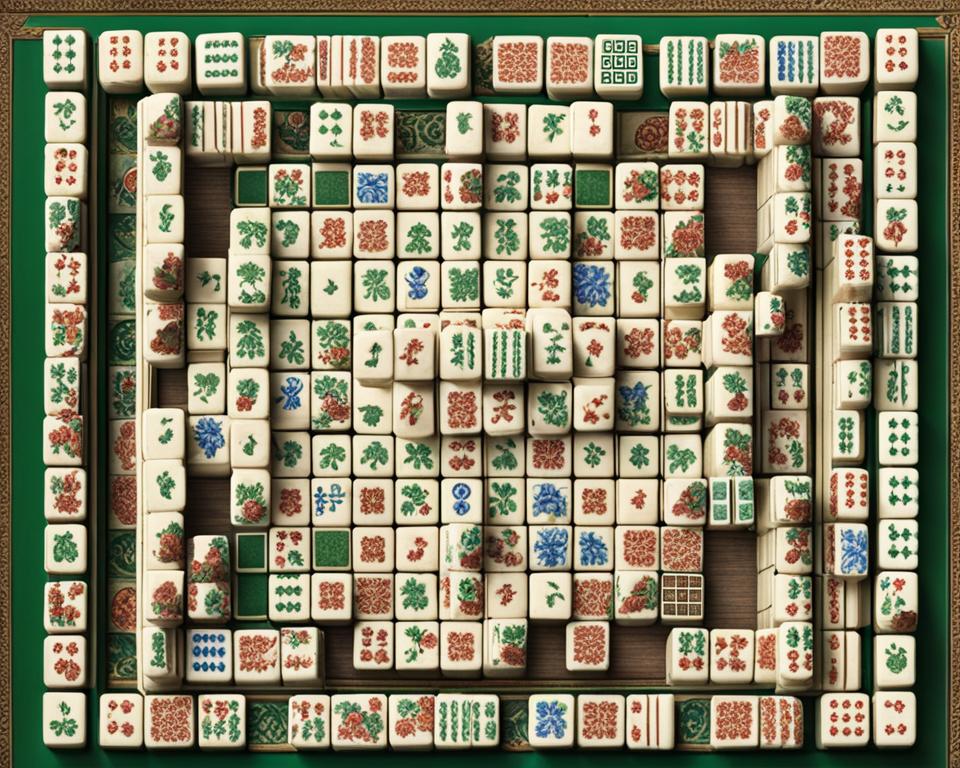
Scoring in Mahjong
In Mahjong, scoring can vary depending on the specific rules being used. It’s essential to establish the scoring system before starting a game and ensure that all players are familiar with the rules. Simple scoring methods typically award points to the player who wins with a complete hand. However, more complex scoring systems take into account different combinations and bonus points for specific achievements.
“Understanding the scoring system is crucial in Mahjong. It adds another layer of strategy and decision-making to the game. By knowing the scoring rules, players can aim for specific hands or configurations that will maximize their score and increase their chances of winning.”
One common scoring method used in Mahjong is based on the value of the winning hand and the specific combinations achieved. Each combination has a fixed value, and the total score is calculated based on the sum of the values. For example, a pung (three of a kind) may have a higher value than a chow (three consecutive numbers in the same suit).
“The scoring system in Mahjong encourages players to strive for certain combinations or patterns to maximize their score. It adds excitement and strategic decision-making to the game, making each round even more thrilling.”
Example Scoring Table:
| Combination | Value |
|---|---|
| Pung | 2 points |
| Chow | 1 point |
| Kong | 8 points |
| Mahjong | 16 points |
“The scoring table provides a clear breakdown of the value assigned to each combination in Mahjong. By referring to this table during gameplay, players can keep track of their score and strategize accordingly to achieve the most valuable combinations. It adds an element of planning and calculation to the game.”
Advanced players may also include bonus points for specific achievements, such as winning with a specific tile or completing a hand within a certain number of turns. These bonus points can significantly increase a player’s score and add an extra level of competition to the game.
It’s important to note that scoring systems can vary depending on the Mahjong variant being played. Some variants may have different values assigned to combinations or include additional scoring elements. Before playing a game of Mahjong, it’s crucial to agree on the specific scoring system to avoid any confusion or disputes.
“Mastering the scoring system in Mahjong takes time and practice. It’s a rewarding aspect of the game that adds depth and complexity to each round. By understanding the scoring rules and regularly playing Mahjong, players can enhance their strategic thinking and improve their overall gameplay.”
Strategies and Tips for Mahjong Beginners
As a beginner in Mahjong, it’s important to learn some basic strategies and tips to improve your gameplay and increase your chances of winning. Here are a few helpful suggestions to get you started:
- Focus on completing sets and pairs: In Mahjong, the key to success is to form sets (three or four tiles of the same type) and pairs (two identical tiles). Pay attention to the tiles you have and try to build sets and pairs as early as possible.
- Observe the discards of other players: To gain an advantage, keep an eye on the tiles discarded by other players. This helps you deduce the tiles they need or want and adjust your strategy accordingly. It can also give you insights into the hands they are trying to build.
- Learn to read the game board: Understanding the overall state of the game is essential. Take note of the tiles that have been played and use that information to make informed decisions about which tiles to discard or keep.
- Practice regularly: Like any skill, Mahjong requires practice to improve. Set aside time to play the game regularly, whether it’s with friends, family, or online. The more you play, the better you’ll become at making strategic decisions and recognizing patterns.
- Play with more experienced players: Playing with experienced Mahjong players can be a great way to learn new strategies and techniques. Observe their moves, ask questions, and take advantage of their knowledge. Over time, you’ll develop a deeper understanding of the game and enhance your skills.
By incorporating these strategies into your gameplay and actively seeking opportunities to improve, you can become a more confident and successful Mahjong player. Remember to have fun and enjoy the process of learning and mastering this captivating game.
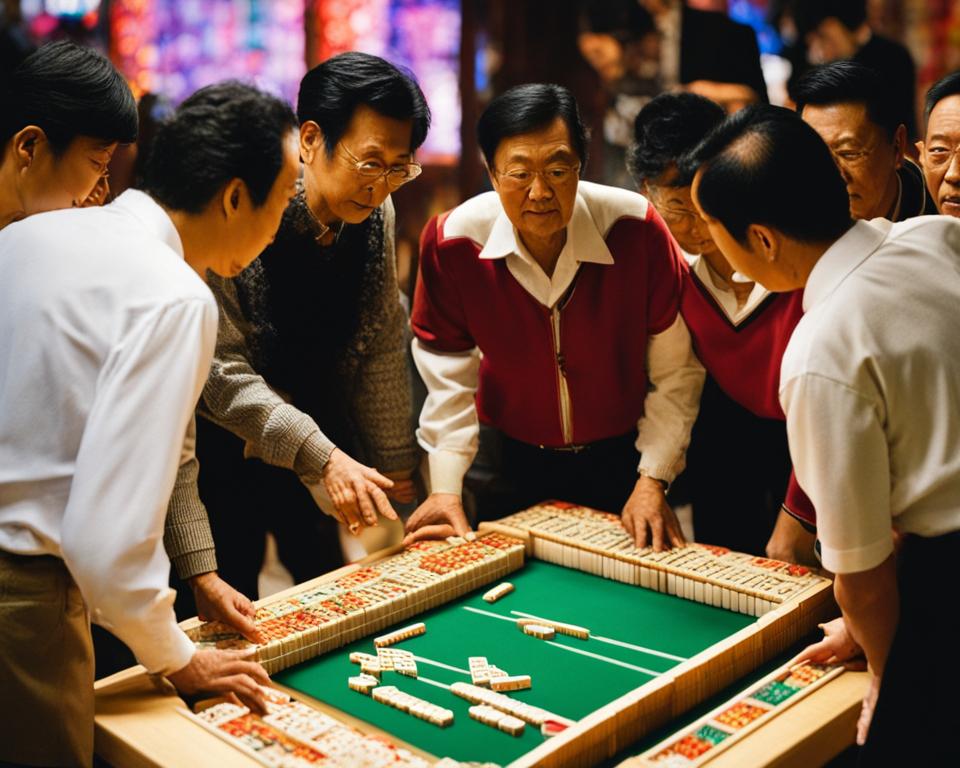
Frequently Asked Questions
Q: Can I win a game of Mahjong solely based on luck?
A: While luck plays a role in Mahjong due to the random distribution of tiles, strategic decision-making and skillful play greatly increase your chances of winning. By applying the right strategies and observing the tiles on the game board, you can improve your overall gameplay and maximize your winning potential.
| Strategy | Description |
|---|---|
| Focus on Completing Sets and Pairs | Build sets and pairs early to increase your chances of completing winning hands. |
| Observing Discarded Tiles | Pay attention to the tiles discarded by other players to gain insights into their hands and adjust your own strategy accordingly. |
| Reading the Game Board | Take note of the tiles that have been played and use that information to make strategic decisions. |
| Practicing Regularly | Regular practice helps improve your decision-making skills and pattern recognition abilities. |
| Playing with Experienced Players | Learn from experienced players and leverage their knowledge to enhance your gameplay. |
Variations of Mahjong
Mahjong is a game with a rich history and cultural significance, and as a result, it has various regional variations that offer unique twists and gameplay mechanics. While the basic principles of Mahjong remain the same across different versions, the specific rules and scoring systems can vary greatly. As a beginner, it’s important to start with the basic rules of American Mahjong and understand its gameplay mechanics before exploring other variations.
Chinese Prevailing Wind System
One popular variation of Mahjong is the Chinese Prevailing Wind System. In this version, players use the prevailing wind to determine the seating arrangement and the order of play. The game revolves around the concept of winds: East, South, West, and North. Each player assumes one of these wind positions and plays according to their corresponding wind. The Chinese Prevailing Wind System adds an extra layer of strategy and depth to the game, making it a favorite among seasoned Mahjong players.
American Mahjong with Special Scoring Cards
American Mahjong, also known as National Mah Jongg League (NMJL) Mahjong, is a popular variation played in the United States. This version features special scoring cards that players use to track their progress and calculate their scores. The cards provide a comprehensive list of winning combinations and hands to strive for, making it easier for beginners to understand and follow the rules. American Mahjong also incorporates joker tiles, which can be used as substitutes in certain combinations, adding an extra layer of excitement to the game.
Exploring the various Mahjong variations allows players to experience different rule sets and strategies. However, it’s important to note that each variation requires a specific set of skills and knowledge, and it’s best to master the basics of American Mahjong before branching out. By starting with the simple guide to playing Mahjong and gradually expanding their horizons, players can discover the exciting world of Mahjong in all its diverse forms.
Conclusion
Mastering the basic rules of Mahjong is the key to becoming a skilled and successful player. It is a game that combines strategy, skill, and a bit of luck, making it both challenging and exciting. By understanding the rules, familiarizing yourself with the tiles, and practicing regularly, you can improve your Mahjong skills and enjoy the game to its fullest.
Remember that Mahjong is not just about winning, but also about having fun and enjoying the process of learning. It is a game that requires patience and concentration, so take your time to make the right moves and analyze the board. The more you play, the better you will become, and the more strategic you will be.
As you continue your Mahjong journey, consider exploring different variations of the game. While the basic rules remain the same, each variation brings its own unique twists and challenges. Whether you choose to play American Mahjong, Chinese Mahjong, or any other variation, the core principles of the game will stay with you.
FAQ
What are the basic rules of Mahjong?
Mahjong is a 4-person game where each player starts with 13 tiles. The goal is to create a hand of four sets and one pair. Players take turns discarding and drawing tiles, aiming to complete sets or declare Mahjong with a winning hand.
What are the different types of tiles in Mahjong?
An American Mahjong set consists of 152 tiles, including suits such as craks, dots, and bams. Each suit has tiles numbered from 1 to 9, and there are 4 instances of each tile. There are also wind tiles, dragon tiles, flower tiles, and jokers that play specific roles in the game.
How do I read the Mahjong card?
The Mahjong card describes the winning combinations of tiles, also known as “hands.” It uses abbreviations and symbols to represent different combinations, such as pung, kong, and quint. Familiarize yourself with the card to understand the different combinations and how to follow them during gameplay.
How do I set up a game of Mahjong?
To set up a game of Mahjong, players arrange themselves around a table and build a wall of face-down tiles in front of them. The dealer rolls dice to determine the starting point for dealing tiles. Each player receives 13 tiles, and the dealer receives an extra 14th tile. Organize and conceal your tiles while preparing for gameplay.
How does gameplay and turn taking work in Mahjong?
Gameplay involves players taking turns discarding a tile from their hand and drawing a new tile. You can draw from the wall or from a discard pile. Players can claim a discarded tile to complete a set or declare Mahjong if they have a winning hand. It’s important to understand the rules of turn-taking and tile exchange.
How is scoring done in Mahjong?
Scoring in Mahjong can vary, but a simple method awards points to the player who wins with a complete hand. More complex systems consider different combinations and give bonus points for specific achievements. Establish the scoring system before starting a game and ensure all players understand the rules.
What are some strategies and tips for Mahjong beginners?
Beginner strategies include focusing on completing sets and pairs, paying attention to other players’ discards, and learning to read the game board. Regular practice and playing with more experienced players can also enhance your Mahjong skills.
Are there different variations of Mahjong?
Yes, Mahjong has many regional variations, including the Chinese prevailing wind system and American Mahjong with special scoring cards. Start with the basic rules of American Mahjong and explore other variations once you have mastered the fundamentals.
How can I improve my Mahjong skills?
To improve your Mahjong skills, understand the rules, familiarize yourself with the tiles, and practice regularly. Focus on strategy and learn from more experienced players. Enjoy the process of learning and improving your Mahjong skills.

